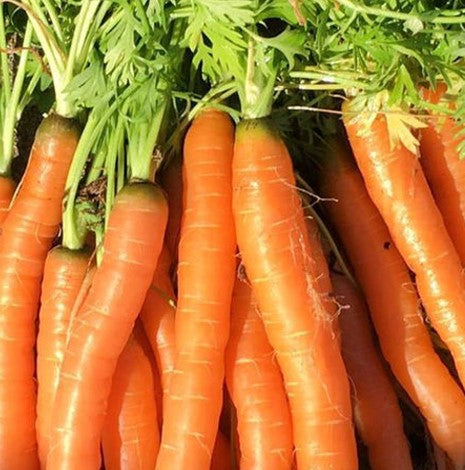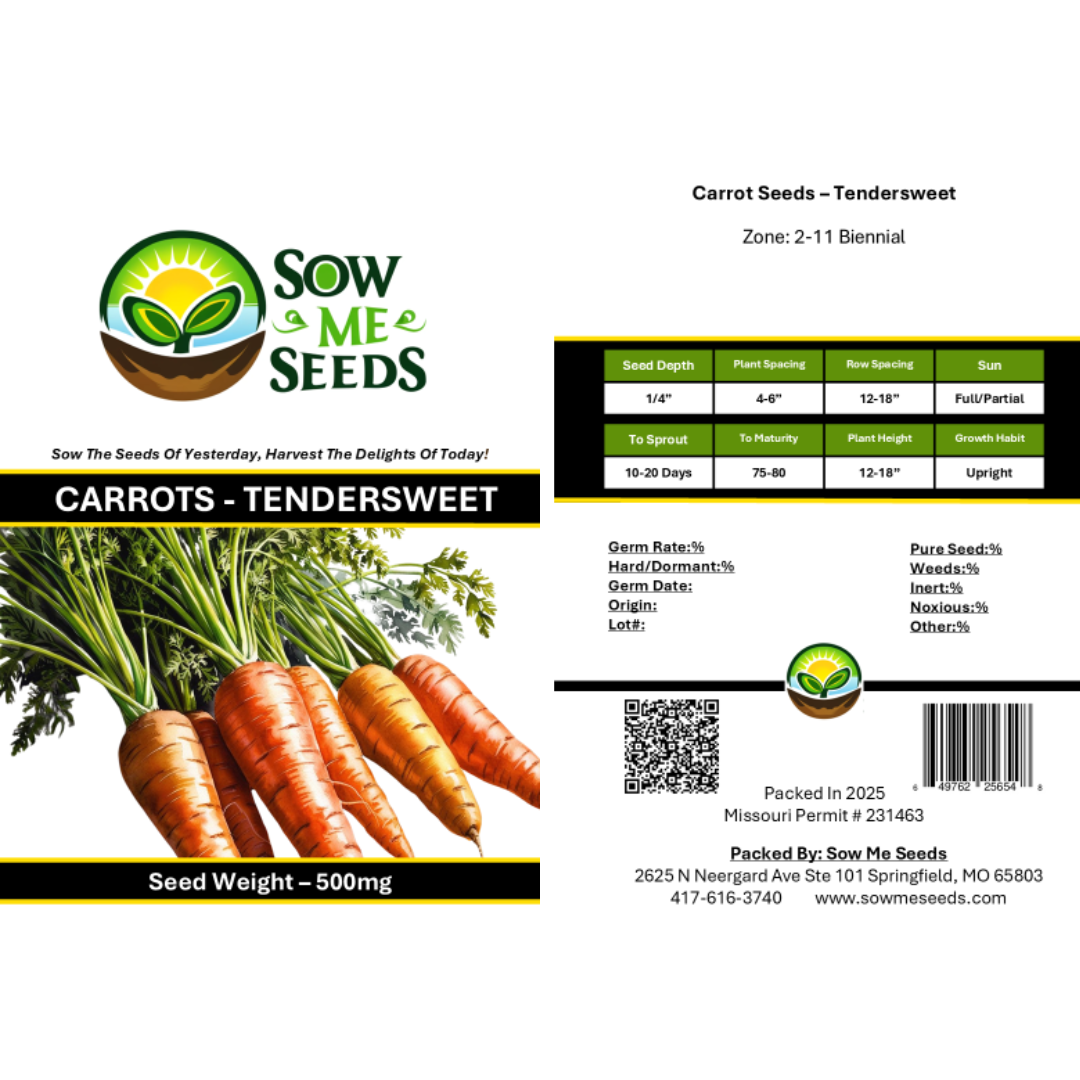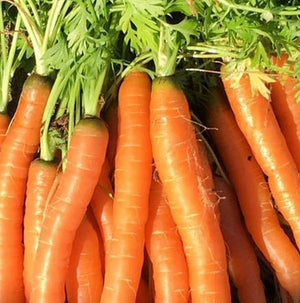- Hardiness Zone: 2-11 Annual
Seed Depth: 1/4 inch
Seed Spacing: 1–2 inches
Row Spacing: 12–18 inches
Sunlight: Full sun to partial shade
Days to Sprout: 10–20 days
Days to Maturity: 75–80 days
Growth Habit: Upright, Slender Root Crop
Sunlight: Choose a location that receives full sun for at least 6-8 hours a day. Carrots grow best in sunny locations, although they can tolerate light shade.
Soil: Prefers loose, well-drained, sandy or loamy soil with a pH between 6.0 and 7.0. Carrots need deep, loose soil free of rocks and debris to grow straight and long. Amend the soil with compost or well-rotted manure before planting to improve fertility and drainage.
When to Plant: Carrots are a cool-season crop that can be planted in early spring or late summer for a fall harvest. Sow seeds directly in the garden 2-4 weeks before the last expected frost date in spring, or in late summer when temperatures begin to cool down.
Direct Sowing: Sow seeds 1/4 inch deep and 1-2 inches apart in rows spaced 12-18 inches apart. Carrot seeds are tiny, so try to space them evenly. Thin seedlings to 2-3 inches apart once they are a few inches tall to allow enough space for the roots to develop properly.
Indoor Sowing: Not recommended; carrots perform best when direct sown.
Succession Planting: Sow every 2–3 weeks for a continuous harvest throughout the season.
Watering: Keep the soil consistently moist but not waterlogged. Carrots need regular watering, especially during dry periods, to ensure even moisture. Watering deeply encourages the roots to grow long and straight. Avoid letting the soil dry out, as this can cause the roots to become tough or misshapen.
Fertilization: Carrots do not require heavy fertilization. Apply a balanced fertilizer or compost at planting time. Avoid using high-nitrogen fertilizers, as they can cause excessive foliage growth at the expense of root development. Side-dress with compost or a low-nitrogen fertilizer if the plants appear to need a nutrient boost.
Mulching and Weeding: Apply a thin layer of mulch around the seedlings to retain soil moisture, suppress weeds, and keep the soil temperature consistent. Be careful when weeding around young carrot plants, as their roots are delicate and can be easily disturbed.
Pruning: No pruning is needed; harvest greens sparingly for culinary use.
Thinning: Thin carrot seedlings to 2-3 inches apart once they are a few inches tall. Thinning is essential to ensure that the roots have enough space to grow straight and large. Thin the seedlings by snipping them at the soil level rather than pulling them out, which can disturb the roots of nearby plants.
Pest and Disease Management: Carrots can be susceptible to pests such as carrot flies, aphids, and nematodes. Use row covers to protect young plants from pests and practice crop rotation to reduce the risk of soil-borne diseases. Carrots are relatively disease-resistant, but proper spacing and good air circulation can help prevent fungal issues.
When to Harvest: Tendersweet Carrots are typically ready to harvest 75-80 days after planting. Harvest when the roots are about 6-8 inches long and have a bright orange color. Carrots can be harvested earlier for a more tender and sweet flavor, or left in the ground longer for a larger size.
How to Harvest: Loosen the soil around the roots with a garden fork or trowel before gently pulling the carrots out of the ground. Be careful not to break the roots during harvesting. Carrots can be left in the ground until you’re ready to use them, especially in cooler weather.
Storing Fresh Carrots: Freshly harvested carrots can be stored in the refrigerator for up to 2 weeks. Trim the greens off the carrots to prevent moisture loss before storing them in a plastic bag or container. For longer storage, carrots can be stored in a cool, dark place in damp sand or sawdust.
Why You’ll Love It
Extra Sweet Flavor: True to its name, this variety is prized for its mild, sugary taste.
Smooth, Coreless Roots: No tough center — just tender, crisp texture from tip to top.
Perfect for Juicing: Naturally sweet and bright orange with great moisture content.
Long-Term Storage: Keeps well after harvest when stored properly.
Plant Characteristics
Height: 8–12 inches of foliage with roots up to 8–10 inches long
Growth Habit: Upright, leafy tops with long, tapered roots
Root Type: Deep orange, smooth, and slender with a blunt tip
Days to Maturity: 70–75 days
Hardiness: Cool-season biennial grown as an annual
Flavor and Culinary Uses
Flavor: Mild, crisp, and exceptionally sweet — even better after a light frost
Culinary Uses: Ideal for fresh eating, juicing, roasting, steaming, and canning
Companion Planting Tips
Good Companions: Onions, leeks, lettuce, and peas
Avoid Planting Near: Dill and parsnips, which may compete for nutrients
Bonus Benefit: Improves in sweetness when grown in cooler weather
Common Issues and Solutions
Forked Roots: Avoid rocky or compacted soil — grow in loose, deep beds
Poor Germination: Keep soil consistently moist until seedlings emerge
Carrot Rust Fly: Use row covers to protect from this common pest
Seeds Per Packet
| 500mg | Approximately 65 |
| 3g | Approximately 650 |
Why You’ll Love It
Extra Sweet Flavor: True to its name, this variety is prized for its mild, sugary taste.
Smooth, Coreless Roots: No tough center — just tender, crisp texture from tip to top.
Perfect for Juicing: Naturally sweet and bright orange with great moisture content.
Long-Term Storage: Keeps well after harvest when stored properly.
Plant Characteristics
Height: 8–12 inches of foliage with roots up to 8–10 inches long
Growth Habit: Upright, leafy tops with long, tapered roots
Root Type: Deep orange, smooth, and slender with a blunt tip
Days to Maturity: 70–75 days
Hardiness: Cool-season biennial grown as an annual
Flavor and Culinary Uses
Flavor: Mild, crisp, and exceptionally sweet — even better after a light frost
Culinary Uses: Ideal for fresh eating, juicing, roasting, steaming, and canning
Companion Planting Tips
Good Companions: Onions, leeks, lettuce, and peas
Avoid Planting Near: Dill and parsnips, which may compete for nutrients
Bonus Benefit: Improves in sweetness when grown in cooler weather
Common Issues and Solutions
Forked Roots: Avoid rocky or compacted soil — grow in loose, deep beds
Poor Germination: Keep soil consistently moist until seedlings emerge
Carrot Rust Fly: Use row covers to protect from this common pest
Seeds Per Packet
| 500mg | Approximately 65 |
| 3g | Approximately 650 |




Share and get 15% off!
Simply share this product on one of the following social networks and you will unlock 15% off!